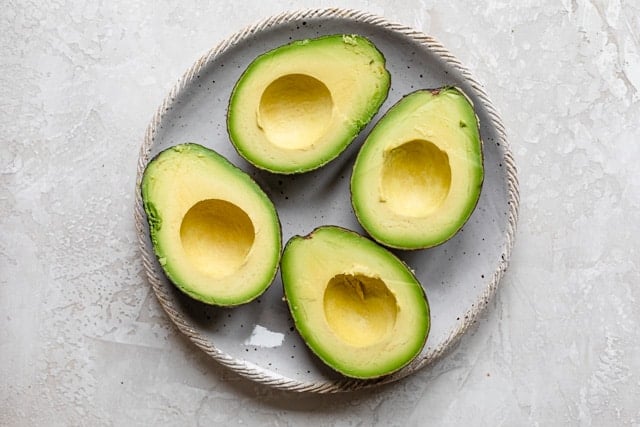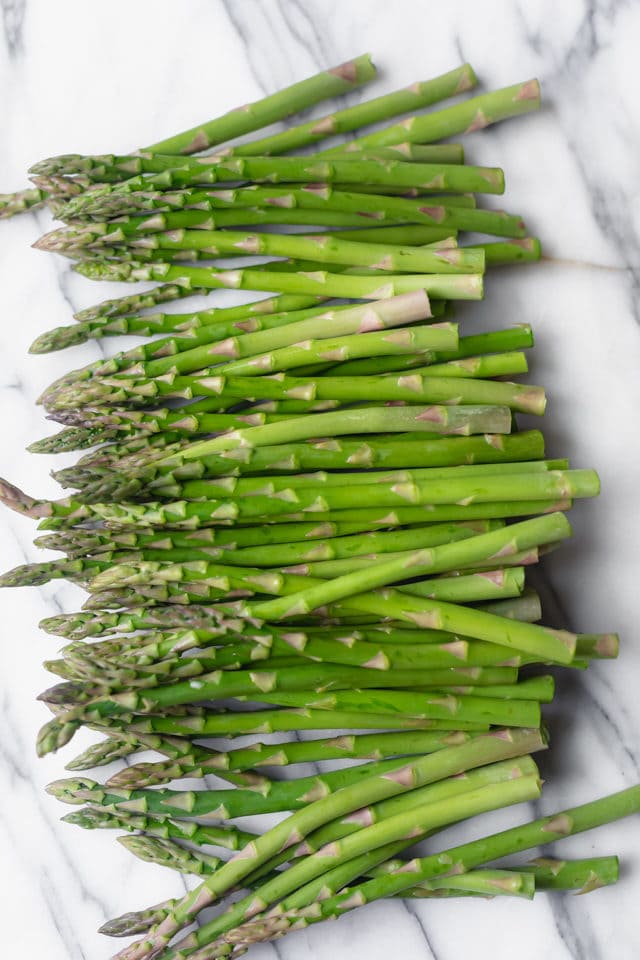This post may contain affiliate links. Please read our disclosure policy.
Fresh spring produce is coming into the stores every day. Here is your guide to all that spring-time goodness. I share why I believe it’s important to eat seasonally, how to pick the best produce for the season and a complete list of the most popular spring fruits and vegetables.
Why is it important to eat seasonally?
- Fruits and vegetables that are given the time to fully ripen on the plant are richest in nutrients and in flavor. The deliciousness of truly ripe produce is unmatched with the unripe counterparts!
- Ripened fruits and vegetables that are rushed to market retain the maximum amount of their vitamins and minerals. This is why farmer’s market produce is often the healthiest!
- In-season produce is often the most affordable because of its abundance in stores and markets.
- Eating seasonally and locally means that your food’s shorter trip from field to market shrinks its carbon footprint.
Tips for shopping for spring produce
With global shipping (off-season blueberries from Chile!) and improved cold storage techniques (hello, fresh apples in spring) our year-round selection of fruits and vegetables is incredible.
Still, when your favorites are in season it’s an excellent idea to do some research on how to select and store the best specimens to get the most out of these seasonal treasures. Here are my tips to keep in mind when shopping:
- Smell the fruit and vegetables. A lovely smell is one indicator that a nectarine is ripe for example, but it might also indicate that a pineapple needs to be cut immediately upon buying.
- Pick up the produce and look for signs for freshness. You want to avoid anything that has bruises, soft softs, or wrinkled skin. Instead look for produce that feels firm but yields to gently applied pressure.
- Check out the websites and/or weekly circulars of your local stores. These can give you a great idea of what’s in season and on sale.
- Be flexible in your meal planning and recipe development. If a recipe normally calls for tomatoes, but tomatoes are not in season, can you substitute it for plums or strawberries instead?
Seasonal spring fruits
Below you will find a list -from the USDA and other sources – of spring fruits generally available across the country during the spring but, of course, your local finds will vary by climate.
- Apricots
- Blackberries
- Blueberries
- Cherries
- Kiwi fruit
- Kumquats
- Mangos
- Lemons
- Limes
- Pineapples
- Plums
- Pluots
- Rhubarb
- Strawberries

Seasonal spring vegetables
When it’s time to start enjoying spring vegetables like asparagus, artichokes, and peas, look for undamaged, unblemished produce. Ask farmers and produce workers what they like best, too! “What’s good today?” is always a great question. Some vegetables, like spinach, are available year-round but best in spring.
- Asparagus
- Artichokes
- Avocados
- Fennel
- Fiddleheads
- Leeks
- Morel mushrooms
- Peas
- Radishes
- Spinach

Here are my favorite spring produce recipes
Below are some of my favorite recipes to make for spring from soups, to salads, pancakes and desserts. Be sure to check out my 25 Fresh Spring Recipes for more inspiration for breakfast, lunch, dinner and desserts!
- Vegan Asparagus Soup
- Peas and Carrots Stew
- Strawberry Mango Smoothie
- Avocado Blueberry Salad
- Lemon Ricotta Pancakes
- Lemon Blueberry Bread
- Easy Lemon Bars
- Strawberry Rhubarb Crisp
- Vegan Spinach Artichoke Dip
- Potato Leek Soup
Frequently asked questions
If you can’t buy fresh spring produce, opt for frozen or canned. Harvard School of Public Health says “in certain cases, frozen or canned produce may contain higher levels of nutrients than fresh produce stored for too long. To obtain the most nutrients, consume fresh produce within a few days, or frozen varieties within a few weeks.“
See this guide on freezing any extra fruits or vegetables. You can also cook and freeze in your favorite recipes.
As Jerry Seinfeld put it on a Seinfeld episode about Mackinaw peaches, “Fruit’s a gamble. I know that going in.”‘ Sometimes you get a bad batch. Especially in these days of Covid-19, when sampling at stores is on hold.
It can be hard to keep track of everything so I recommend buying what you need, using as quickly as possible and storing according to recommendations which vary based on the produce. Encyclopedic books like The New Food Lover’s Companion show how to store an incredible array of produce
For more cooking guides
- How to Stock your Pantry
- How to Stock a Freezer
- How to Cook with Canned Tomatoes
- 16 Pantry Meal Ideas
- 15 Easy No Bake Desserts
- 10 Recipes with Vegetable Broth
- Daily Breakfast Ideas to Stay Healthy
Shopping seasonally gets me out of cooking ruts and is a delicious way to change up weekly menus and the nutrients we put in our bodies. Check out this cool website and app, which tells you exactly what is in season state-by-state.
Just remember: while it is great to have a master list written out before you visit the store, be flexible. Check out what looks best in your market and buy accordingly.
If you find this spring produce guide useful, I’d love to hear from you! And if you snapped some shots of any of these tips and tricks, please share it with me on Instagram so I can repost on my stories!
